The 2011 MacBook Air (11 & 13-inch): Thoroughly Reviewed
by Anand Lal Shimpi on July 28, 2011 3:25 AM EST- Posted in
- Apple
- Mac
- Intel
- Sandy Bridge
- MacBook Air
- Laptops
A New Thunderbolt Implementation
The other major change to the new MacBook Air is support for Intel's new Thunderbolt interface. We first met Thunderbolt on the 2011 MacBook Pro and saw it again on the iMac. Both the new Mac mini and the MacBook Air now support Thunderbolt as well, although the Air's implementation is slightly different.
If you look at iFixit's teardown of the new 13-inch MacBook Air you'll notice the absence of the traditional flip-chip Thunderbolt controller from the MacBook Pro, iMac and Mac mini. In fact, there are only two flip-chip parts on the motherboard - the Core i5 and the QS67 chipset.

13-inch MacBook Air (Mid 2011) Motherboard, QS67 (left), Intel Core i5 (right) - Courtesy iFixit
iFixit assumed that the QS67 chipset integrated Intel's Thunderbolt controller. Unfortunately there are a couple of things wrong with this assumption. First off, Intel has already announced that Thunderbolt wouldn't even be integrated in Ivy Bridge chipsets next year. While it's possible that Apple could request a special chipset from Intel, Apple would have to pay for the added design, manufacturing and validation costs or commit to huge volume numbers in order to make the effort worthwhile for Intel.
The second problem with the assumption has to do with the QS67 die itself. It looks unchanged from the square 6-series chipset die we saw back at CES earlier this year:
I didn't measure the two but they do look awfully similar. It's far more likely that the Thunderbolt controller is simply elsewhere on the motherboard. But where?
In all existing Thunderbolt Macs, the controller is very close to the Thunderbolt port. Looking carefully at the new MacBook Air you'll notice a tiny Intel chip near the Thunderbolt port:

Intel's Eagle Ridge SFF Thunderbolt Controller - Courtesy iFixit
This is a brand new Thunderbolt controller from Intel - codenamed Eagle Ridge. The chip used in the MacBook Pro, iMac and Mac mini is called Light Ridge and it looks like this:
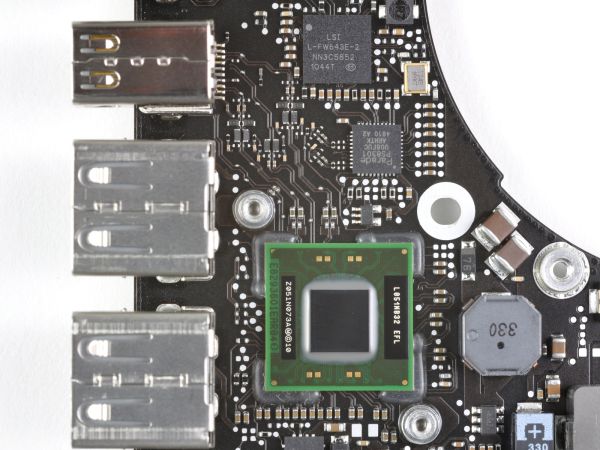
Light Ridge Thunderbolt Controller IC on 15" 2011 MacBook Pro - Courtesy iFixit
Light Ridge supports four bidirectional 10Gbps channels (20Gbps total per channel) channels and two DisplayPort inputs/outputs. On the iMac it's used to drive two ports on the back of the system.
Eagle Ridge is half of Light Ridge. You get two bidirectional 10Gbps channels (20Gbps total per channel) and one DisplayPort input/output. Eagle Ridge is offered in both a normal and small form factor package, the SFF version is what's used in the MacBook Air. I suspect Eagle Ridge is the cost reduced version of Intel's Thunderbolt controller Apple needed to maintain profit margins while bringing out a $999 MacBook Air with Thunderbolt.
Both the 11 and 13-inch MacBook Air have a single Thunderbolt port. This port is on the right side of both machines in the same location as the miniDP receptacle in last year's model.
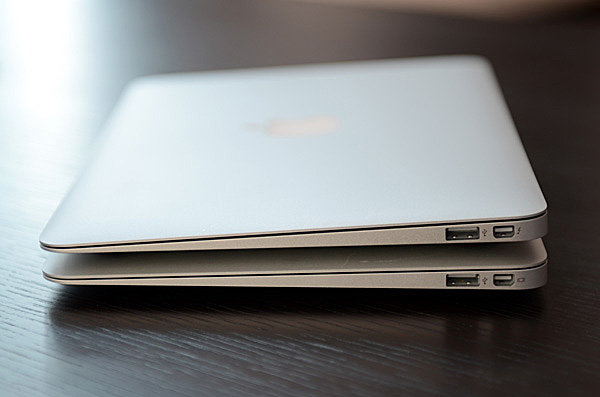
The Thunderbolt port on the new 11 (top)
I already mentioned that functionally Thunderbolt in the MacBook Air is no different than in the MacBook Pro. A quick visit to Windows 7's device manager confirms that the Thunderbolt controller branches off of the CPU's on-die PCIe controller:
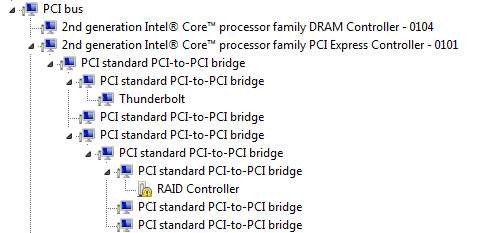
The unidentified RAID device is a Promise Pegasus R6, which still lacks driver support under Windows. With no discrete GPU in the MacBook Air there are more than enough PCIe lanes for Thunderbolt, but this controller still only uses (and needs) 4 of them.
Both DisplayPort and PCIe are carried over to the Thunderbolt port on the system. Apple clarified that you can in fact mix video and PCIe traffic on a single channel or across multiple channels. This gives you 20Gbps of upstream bandwidth and 20Gbps of downstream bandwidth to use however you want. Remember that driving a single 27-inch 25x14 display uses up around 7Gbps of upstream bandwidth alone, but there's still more than enough for storage and other needs.
I tested the Pegasus R6 with both MacBook Airs and its performance was similar to the MacBook Pro:
| Promise Pegasus R6 12TB (10TB RAID-5) Performance | ||||||
| Sequential Read | Sequential Write | 4KB Random Read (QD16) | 4KB Random Write (QD16) | |||
| 15-inch MacBook Pro (Early 2011) | 673.7 MB/s | 683.9 MB/s | 1.24 MB/s | 0.98 MB/s | ||
| 13-inch MacBook Air (Mid 2011) | 647.4 MB/s | 724.9 MB/s | 1.38 MB/s | 1.37 MB/s | ||
| 11-inch MacBook Air (Mid 2011) | 627.6 MB/s | 723.3 MB/s | 1.37 MB/s | 1.37 MB/s | ||
Write speeds were a bit higher but I suspect that has more to do with changes to performance under Lion than anything inherent in the hardware.
Thunderbolt devices appear under System Profiler the same way they do on the MacBook Pro:

The Thunderbolt port can also function as a miniDP output which works as expected on the Air. UI performance is ok on a 27-inch Cinema Display driven by a MacBook Air despite the lack of a dedicated high speed frame buffer. The biggest issue is that firing up Mission Control or swiping between Spaces is met with a significantly reduced frame rate. If you're going to be using a high resolution external panel regularly, you might want to consider a MacBook Pro with a lot of dedicated video memory.
Note that the Air can only drive a single external display. Not only does the Eagle Ridge Thunderbolt controller only support one DisplayPort output but Intel's HD 3000 GPU only supports two display outputs and one is already occupied by the Air's panel.
The Thunderbolt Display
Neither MacBook Air has an integrated Ethernet controller, there's no need as neither system is physically thick enough to accommodate a standard RJ45 connector. Apple has sold a USB 10/100 Ethernet dongle in the past for MacBook Air owners, but these days you can get better performance over good WiFi than you can from 100Mbps Ethernet. This is where that magical Thunderbolt port comes into play.
Remember Thunderbolt is just a carrier for PCI Express and DisplayPort. Any device that lives off of a PCIe bus can in theory be used over Thunderbolt. Typically your GigE controller is a PCIe device that resides on your motherboard. Sonnet took a PCIe Gigabit Ethernet controller, put it in a small box along with a Thunderbolt controller and built this:
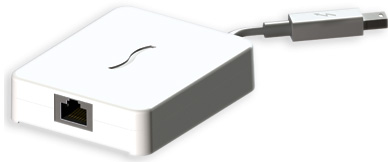
The Presto Gigabit Ethernet Thunderbolt Adapter is all you'd need to add GigE support to the MacBook Air. Need FireWire 800 support? Sonnet announced one of those too:
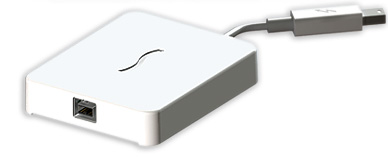
There's a total of 20Gbps of bandwidth in either direction over Thunderbolt, which is more than enough for 1Gbps of traffic over Ethernet or 800Mbps of traffic over Firewire. Availability is slated for "this summer" for both of these devices.
Rather than building individual cables, Apple did almost exactly what I asked for and built a monitor with more IO. It's called the Thunderbolt Display and it features an integrated USB 2.0, FireWire 800, Gigabit Ethernet and audio controller. All of these controllers reside on PCIe and are tunneled over to the host Mac via a single Thunderbolt cable.
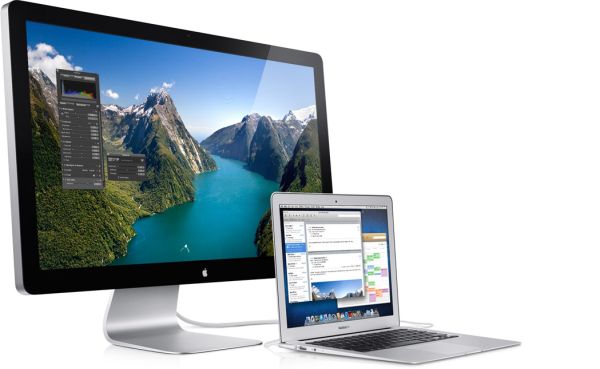
While the MacBook Air doesn't support FireWire 800 or Gigabit Ethernet, paired with a dongle, breakout box or Thunderbolt Display you can add those options presumably without giving up performance.
This is what Thunderbolt was meant to do. All we need now is widespread adoption, more accessories and a standard for external GPU form factors.


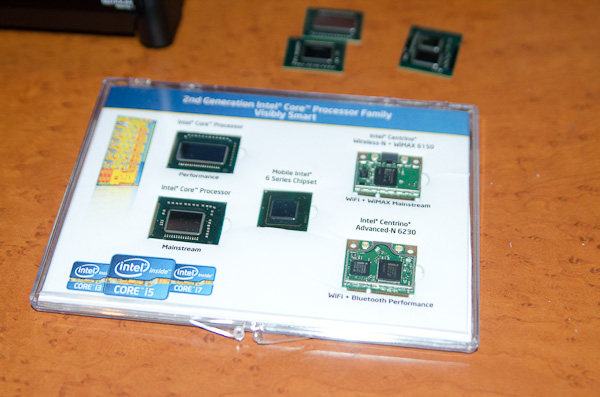








103 Comments
View All Comments
OCedHrt - Tuesday, August 2, 2011 - link
35W is maximum draw I think. On average you don't use that much, and on idle you save even less. My Z, as an entire system, draws 22W on average during browsing.darwinosx - Saturday, July 30, 2011 - link
If you had actually read the review or knew anything about the Sony Z you would know that this is a different ultra low voltage i5 processor that was just released. You would also know that Sony's are higher priced, poorly made, little service and support, and run Windows.OCedHrt - Tuesday, August 2, 2011 - link
I would know that my Z runs fast, plays my games, carries around just as light as an Air, is built to last, never needed support, and cost me less. And people still have their 3 gen old Z's running core duos going strong.The Z does not want a ULV processor. ULV is only good if you want to increase your battery life at the cost of performance. The Sony Z does not lose to Air in battery life at all. Just because something just came out doesn't necessarily make it ideal. Would there be a market for the new Z with ULV? Maybe, and it will then kill the Air in battery life and probably cost even less.
KPOM - Thursday, July 28, 2011 - link
As usual, a nice and thorough review. Thanks for the comparison to the i7, as well.Apple did a nice job with this one. They have created a mainstream "ultra book" months before the others come out with their blessed-by-Intel versions. It isn't as powerful as the Vaio X, but is more reasonably priced. It beats the relatively new Samsung Series 9 (which still relies on an i3 and less powerful graphics) while maintaining similar pricing. The i7 available in the 128GB 11" is a good deal at $1349. I opted for the 256GB 11" and got the Samsung (though the Toshiba would have been fine - I had one in my 2010 MacBook Air).
OCedHrt - Tuesday, August 2, 2011 - link
I hope you mean the Vaio Z. The X was amazing but it was a paper weight.iwod - Thursday, July 28, 2011 - link
The next gen of tech, Haswell, PCI-E 4.0, Thunderbolt 2.0, Faster SSD will be perfect fit for Macbook Air.lokiju - Thursday, July 28, 2011 - link
I wonder if Sony's Air challengers external GPU would work with this if you could get the physical ports adapted to fit...A external GPU would probably be more than it's worth for me but still a cool concept.
mschira - Thursday, July 28, 2011 - link
That last sentence made me think. Why not integrate the external graphic card into the external display?That would be neat.
M.
wicko - Thursday, July 28, 2011 - link
I think I would still prefer an external GPU kit or something. This way you still have choice in GPU and in monitor, including existing ones.tipoo - Thursday, July 28, 2011 - link
I'd prefer a separate box for the GPU so you don't have to toss the display when its outdated. With thunderbolt you could potentially connect the Air to the display, then daisychain the display to the GPU.